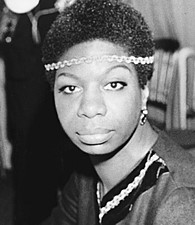Jazz singer Nina Simone revolutionized popular music and emerged as one of the finest songwriters and musicians of her time. In addition to captivating audiences with her talent and passion, she remained a fierce advocate for the Civil Rights movement. FindingDulcinea provides a glimpse into the life and work of the woman who refused the term “jazz” in favor of “African-rooted classical music.”
Nina Simone’s Early Days
Nina Simone was born Eunice Kathleen Waymon on February 21, 1933, in Tryon, North Carolina, the sixth of eight children. She began playing the piano at age three, and her mom worked as a maid to support her classical piano lessons.
The promising musician attended boarding school and then transferred to the Juilliard School of Music for her last year of high school, with help from her admiring audiences. At the age of 21, her aspiration to attend the elite Curtis School of Music in Philadelphia was curbed after being denied a scholarship, which she believed was due to racial inequity. (Years later, she received her honorary Fine Arts doctorates from both Curtis and Julliard; after that, she called herself Dr. Nina Simone.)
She began playing piano in Atlantic City, using the stage name Nina Simone—in homage to French cinema legend Simone Signoret—so that her minister mother wouldn’t find out that she was performing in nightclubs. The night after her first gig, the venue’s owner demanded that she sing as well as play; she soon became a sensation among the local nightclub circuit. She left New Jersey for New York, first performing in Greenwich Village and eventually at Carnegie Hall, where she performed jazz and blues numbers.
The Woman and Her Work
- “I Put A Spell On You: The Autobiography of Nina Simone” by Nina Simone
- “To Be Free (Box Set)”
- “Anthology”
- “The Very Best of Nina Simone, 1967–1972: Sugar in My Bowl”
- “Little Girl Blue”
Notable Accomplishments
In 1958, Simone’s debut album “Little Girl Blue,” which included her hits “I Loves You, Porgy” and ”My Baby Just Cares For Me,” sold a million copies. As the civil rights movement began to heat up, she switched from performing love songs to composing such civil rights anthems as “Old Jim Crow” and “Mississippi Goddam,” written in response to the assassination of Medgar Evers and the bombing deaths of four little girls in Birmingham. Simone explained, “You can be a complete politician through music. I have become more militant because the time is right.”
She became close to Martin Luther King Jr. and often sang “We Shall Overcome” during marches. Three days after King was assassinated in 1968, Simone performed “Why? (The King of Love is Dead)” written by her bass player in reaction to the tragedy.
Sources in this Story
- Nina Simone.com: Bio
- YouTube: Nina Simone “My Baby Just Cares For Me”
- YouTube: Nina Simone ‘Mississippi Goddam’—Live in the Sixties (4)
- The Guardian: Obituary: Nina Simone
- NPR: ‘Why?’: Remembering Nina Simone’s Tribute to the Rev. Martin Luther King. Jr.
- The Independent: Nina Simone: Maverick singer with forthright political views
The Rest of the Story
Simone left the United States for good in the 1970s, declaring that she could no longer endure racism. She lived in Egypt, Barbados, Switzerland, Turkey, Liberia, and Holland before settling in France in 1994. She continued to perform, but suffered many setbacks in her personal life, including divorces and serious financial and emotional problems.
She gained new popularity in 1987, when a Chanel commercial used an early version of “My Baby Just Cares for Me,” which became a hit throughout Britain and was later used in the 1996 movie “Stealing Beauty.” She published an autobiography, “I Put a Spell on You,” in 1992, and put out the album “A Single Woman” in 1993, the same year that many of her songs were showcased in the film “Point of No Return.”
Nina Simone died on April 21, 2003 in her Carry-le-Rouet, France home, leaving behind her only daughter, Lisa Celeste Stroud, and the following words: “I want to be remembered as a diva who never compromised in what she felt about racism and how the world should be, and who consistently stayed the same.”
This article was originally written by Jen O’Neill; it was updated by January 5, 2017.











